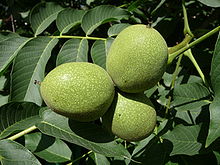Allelopathy
Under Allelopathie refers to interactions that produced by the release of itself or released during disintegration chemical compounds (allelochemicals) between plants of the same or different species, plants and microorganisms or plants and fungi are induced. The Chemical Ecology describes the synthesis , distribution, persistence and effect of these substances in the recipient organism.
Allelochemicals are usually products of secondary plant metabolism and are synthesized from a few starting substances (aromatic amino acids, a few others). They are distributed in gaseous (evaporation), liquid (root exudates, leaching through rain, fog, dew) or solid (rotting plants or plant parts).
On the initiative of India was in 1998 , the International Allelopathy Society founded (IAS). Its aim is to promote and disseminate research and knowledge on allelopathy worldwide.
Examples
A classic example of allelopathic effects is the substance juglone released by the real walnut tree ( Juglans regia ) . This gets into the soil from the leaves of the tree through leaching. This initially inactive form is converted there by soil microbes and converted into its active form. Even in very low concentrations, juglone has an inhibiting effect on the germination of other plants.
In the case of aquatic plants, allelopathy is understood to mean the active chemical action of a plant on its environment and thus also on other plants or against algae such as crab claws . Substances that are phytotoxic (or autotoxic to their own species) or algicidal substances are primarily phenols and phenolic compounds. Allelopathic effects do not only exist from plants against plants or algae, but algae can also produce allelopathic substances against plants.
Just like negative effects, positive, beneficial effects can also be triggered in the recipient organism.
Web links
- Transport information service Specialized information on the subject of allelopathy
Individual evidence
- ^ Albert Gossauer: Structure and reactivity of biomolecules , Verlag Helvetica Chimica Acta, Zurich, 2006, p. 277, ISBN 978-3-906390-29-1 .
- ^ Hans-Georg Kramer: Plant aquaristics á la Kramer. Tetra-Verlag, Berlin-Velten 2009, ISBN 978-3-89745-190-2 , pp. 87-89.

